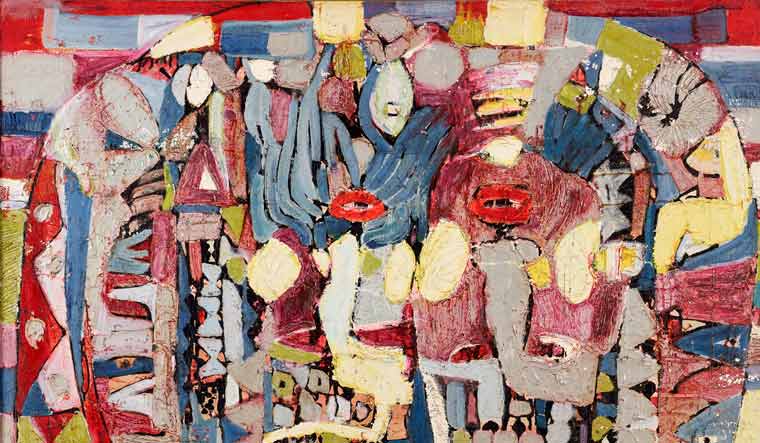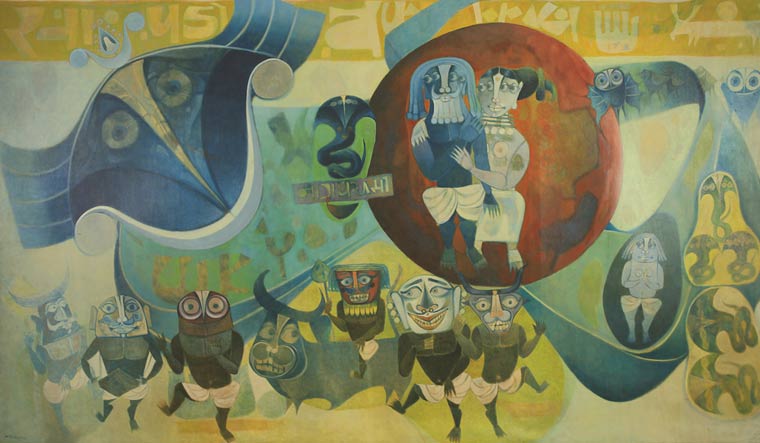A short-lived but significant art movement in Indian modernism was the formation of a collective of 12 young artists in 1962 called 'Group 1890'. It was led by artist and art critic Jagdish Swaminathan, known for setting up the influential multi-arts complex, Bharat Bhawan, in Bhopal and discovering the pathbreaking Gond tribal artist Jangarh Singh Shyam.
But Swaminathan did not care much for applying his strong intuitive faculties for discovering art in south India. In 'Group 1890', Reddeppa Naidu represented Madras. At the time of the formation of the group, Swaminathan was supposed to have confidently remarked, "There is no art beyond the Vindhyas," much to the chagrin of Naidu. In another instance, when Swaminathan was asked by a journalist, "Why do you in the north keep the south Indian artists out of your exhibitions," he had replied," Where are the artists in south India”.
In Delhi Art Gallery's (DAG) sumptuously produced catalogue, 'Madras Modern: Regionalism and Identity', this little anecdote encapsulates the raison d'etre behind mounting a much-needed national retrospective on the Madras Art Movement (1950s-80s). While much has been praised and showcased from the annals of the Bengal School of Art and Bombay Progressive Artists’ Group (right after 1947) to highlight modernity in Indian art, the artistic output of Madras was given short shrift in the 1940s. The catalogue goes on to illustrate reasons behind the delayed landing of modernism in the port city's art school curriculum—from a lack of interest in European Modernism at the Madras School of Arts and Crafts when a formidable D.P. Roy Chowdhury was its principal, to an absence of art critics, dealers, collectors, promoters and publishers when compared to Calcutta or Bombay. Artists from Madras decidedly had a hard time making their presence felt in the national art circuit in the middle of 20th century.

It was only after K.C.S. Paniker joined as principal of Madras School of Arts and Crafts (now Government School of Arts and Crafts) in 1957, that the modern phase in Chennai's illustrious art school really began. And Paniker, by then, had already understood the importance of regional sources as wellsprings of inspiration, even while he was drawn to the aesthetics of European Modernism. When in 1954 an art critic in London remarked at the lack of Indianness in his work, Paniker could see the missing link. A nativist agenda was set forth and the concept of 'regional modern' in the south took root. And therefore artists in the Madras Art Movement, while defying any particular identifying traits or formulae, portrayed aspects of primitivism born out their distinctive historical experience. Cultural markers like kolam, folk deities, puppets, toys, masks, tantric yantras, textile designs, temple carvings, astrological diagrams, epics and religious texts were innovatively employed and boldly rendered in a colourful cacophony.
The ongoing exhibition at DAG in Mumbai has put the spotlight on the works of the core group of artists who carved the Madras Art Movement which really began in the early 1960s by fusing indigenist ideas with Western modernist technical approaches. Curated by Ashrafi S. Bhagat, the show revisits the works of S.G. Vasudev, K.C.S. Paniker, K.V. Haridasan, V. Viswanadhan, J. Sultan Ali, K. Sreenivasulu and others, to remind viewers of an overlooked chapter in the history of modern Indian art and examine this regional modernism outside its own geography. The fact this fascinating corpus of artworks arrived so late as a retrospective in a mainstream gallery is indicative of a persistent lack of initiative to foreground lesser-known modernists.
How much of the North-South divide remains in contemporary Indian art today? "Yes, it still remains. Many in the so called north are not aware of contemporary developments in the south. Art magazines included are not interested in covering the south. The four southern states have much to offer in the contemporary developments, but visibility in its projection remains the main reason," says Bhagat.
'Madras Modern' is on view at DAG, Kala Ghoda in Mumbai till 12 October.


